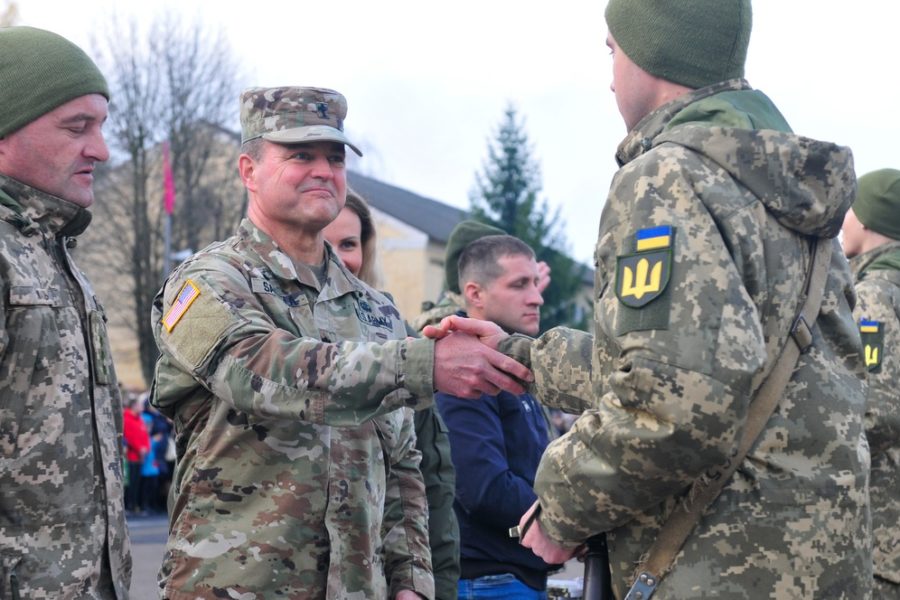For years, the National Guard’s State Partnership Program, whereby individual states partner with other nations’ militaries to provide training and support, flew mostly under the radar. Costing roughly $40 million per year, it represents a tiny fraction of the Pentagon’s budget.
That’s changing as Russia’s invasion of Ukraine stalls amid fierce resistance and the California National Guard’s partnership with Ukrainians is highlighted by local and national media and credited with providing crucial training.
Now, with SPP enjoying a surge in interest, the head of the National Guard Bureau is looking to ensure the program is set for the future.
Speaking at a Heritage Foundation webinar on May 9, Gen. Daniel R. Hokanson said it’s not just California’s National Guard that has helped prepare Ukraine’s armed forces for this moment.
The State Partnership first launched in 1993 following the end of the Cold War, as former Soviet-linked militaries sought American ties. Latvia wanted U.S. help to adopt a citizen-soldier model, similar to the U.S. At the same time, the U.S. government was looking for a way to expand military-to-military cooperation in central and Eastern Europe without threatening the new Russian Federation.
California and Ukraine were matched up that year and have now worked together for nearly three decades. And in that time, service members and leaders have developed tight bonds, something Hokanson argued is only possible with the Guard.
“[Maj. Gen.] Dave Baldwin has been the Adjutant General [of California] for just over 10 years. So because he has been there and because of the National Guard, most of our Soldiers and Airmen stay in that formation or in that state their entire career, the young sergeants that train with Ukrainian sergeants will become command sergeant majors one day, or senior enlisted leaders. And the same with our officers—the captains that trained together eventually become majors, lieutenant colonels, and then in some cases, actually chiefs of defense,” Hokanson said.
“And so if you look at Dave’s span, … because he has been there for almost 10 years, had you picked an Active-duty unit to do that, they would have gone through five or six different commanders. And every three years, the entire unit would have changed out.”
But the benefits of the program aren’t just for the foreign militaries getting to interact with the Guard, Hokanson said.
“One thing it does for the National Guard is it allows our Soldiers and Airmen to really visit a lot of other countries to look at the environment that they operate in, and to really see, in many cases, the same problems, just approached from a different angle. And so we learn a lot in those countries, in those interactions that we bring back to make our organizations better,” Hokanson said.
The program is also good for retention and readiness, Hokanson said, allowing Soldiers and Airmen to travel and gain new experiences. In some cases, he noted, Guardsmen will even visit their state’s partner country in their civilian life because of the bonds and appreciation they have built up.
The way Ukraine’s military is performing during this conflict, defying expectations of a quick Russian victory, is really what’s highlighted the partnership program’s importance. Such a performance, Hokanson said, is “not a surprise to us at all, because we’ve been training them and training with them for almost 29 years.”
That training ratcheted up in intensity after Russia seized Crimea in 2014, with the creation of the Joint Multinational Training Group-Ukraine. Initially, the Army turned to an Active-duty unit to take the lead in training and advising Ukrainian Soldiers.
In 2016, however, the Guard took over. Since then, Hokanson said, “we’ve had eight different Guard states rotate in to do that training, and many of those folks still communicate with folks that they were training with in the Ukrainian army.”
The results speak for themselves.
“We worked very closely with them on small unit tactics, NCO or noncommissioned officer leadership. We worked on joint operations, logistics,” Hokanson said. “And what you’re seeing now is some of the areas that they’re being very successful in, [is] obviously completely attributable to their fact that they’re standing up and they’re fighting for their nation and their sovereignty. But within that, I think we’re also seeing some of that training has been very beneficial to them as well.”
Part of what makes the State Partnership Program so valuable, Hokanson noted, is its affordability. “Our budget is about 1 percent of the DOD budget when it comes to training with allies and partners,” he said. But given the spotlight on Ukraine, the increased emphasis on working with allies and partners in the new National Defense Strategy, and the size of the program, with 87 different partnerships across 93 different countries, there’s also a need to “take advantage of opportunities.”
Specifically, one of the Guard’s top legislative priorities in the coming months “is to ensure that we have consistent stable funding for this program,” Hokanson said.
That’s important, he explained, because other countries and militaries don’t all operate under the same October-to-September fiscal year schedule that the U.S. does. With more predictable, stable funding over time, “we can continue to plan long-term with each of these partners,” Hokanson said.
